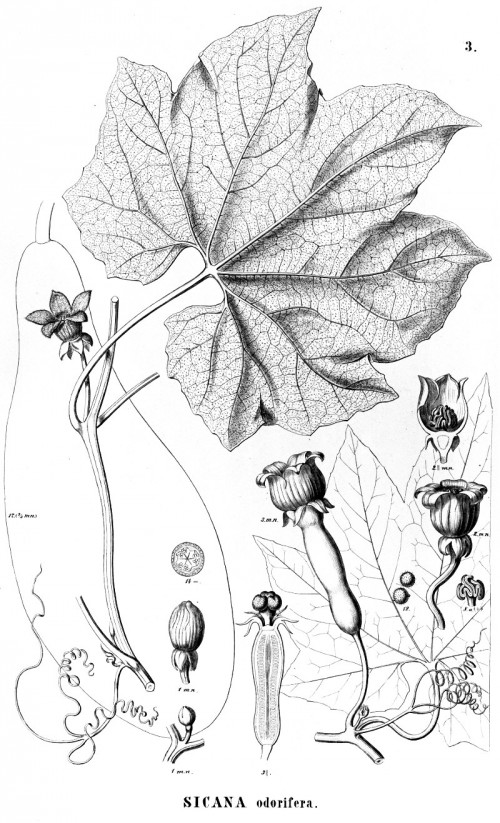Sicana odorifera (Vell.) Naudin - syn.Cucurbita odorifera Vell.; Cucumis odoratissimus Sessé & Moc. - Cucurbitaceae
Melón de olor (span.), cassabanana (port.), casbanan, sikana, musk cucumber, Cassabanana
Perennial vine, climing up to 15m high, native to tropical South America, cultivated as ornamental and aroma plant; flower urn-shaped, white or yellow; fruit hard-shelled, orange-brown to dark purple, up to 40cm long, 8cm in diameter, with fragrant, sweet and edible yellow-to-orange flesh.
The fruit (with apple-like aroma) is used as fragrance for clothes and rooms, lasting months. The fruit is edible before ripening and then used to make candy.
http://es.wikipedia.org/wiki/Sicana_odorifera
„The ripe flesh, sliced thin, is eaten raw, especially in the summer when it is appreciated as cooling and refreshing. However, it is mainly used in the kitchen for making jam or other preserves. The immature fruit is cooked as a vegetable or in soup and stews… People like to keep the fruit around the house, and especially in linen- and clothes-closets, because of its long-lasting fragrance, and they believe that it repels moths. It is also placed on church altars during Holy Week.“
[Morton, J. 1987. Cassabanana. p. 444-445. In: Fruits of warm climates. Julia F. Morton, Miami, FL.]
https://www.hort.purdue.edu/newcrop/morton/cassabanana.html
„Free and glycosidically bound volatiles obtained from the fruit pulp of Sicana odorifera by liquid−liquid extraction and by chromatography, followed by enzymatic hydrolysis with Rohapect D5L, respectively, were analyzed by capillary gas chromatography (HRGC), HRGC−mass spectrometry (HRGC−MS), and HRGC−Olfatometry (HRGC−O) analyses. A total of 37 free volatiles was detected, with the major components being 3-methyl-2-butanol, 3-hydroxy-2-butanone, ethyl 3-hydroxybutanoate, and (Z)-3-hexenol . Among the 22 detected glycosidically bound compounds, 4-hydroxybenzyl methyl ether, 4-hydroxybenzyl alcohol, and 2-phenylethanol were found to be the major constituents. Additionally, two glucoconjugates were isolated in pure form by multilayer coil countercurrent chromatography (MLCCC) of the glycosidic extrac and further purification. Their structures were elucidated by MS and NMR analyses to be the novel [4-(β-d-glucopyranosyloxy)benzyl] 2,3-dihydroxy-3-methylbutanoate 2, and the known 4-(β-d-glucopyranosyloxy)benzyl alcohol 1. Compounds 1 and 2 are precursors of 4-hydroxybenzyl alcohol, one of the major volatiles generated by enzymatic hydrolysis of the glycosidic fraction.“
[Free and Bound Volatile Composition and Characterization of Some Glucoconjugates as Aroma Precursors in Melón de Olor Fruit Pulp (Sicana o dorifera)., Parada, F., Duque, C., Fujimoto, Y., Journal of agricultural and food chemistry, Vol.48(12), 2000, 6200-6204]

Martius, C., Eichler, A.G., Urban, I., Flora Brasiliensis, vol.6(4), f.78, t.3 (1878) [J.Seboth]
http://plantgenera.org/species.php?id_species=943996